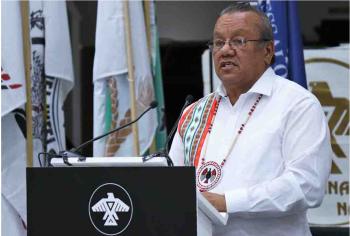Image Caption
Local Journalism Initiative Reporter
Windspeaker.com
Ontario Regional Chief Glen Hare was visibly shaken when he addressed media March 19 near the end of the first day of a three-day inaugural conference on First Nations Community Wellness.
He had just received “heavy heart news” that former National Hockey League player and Stanley Cup champion Chris Simon had died by suicide the previous night.
“Here is an example of ‘where was the support for a man we idolized around the world, who captured many audiences of who we are’ and he was our enforcer,” said Hare.
Hare said he often visited Simon’s family in Wawa, Ont. on his travels.
Later he said that federal and provincial politicians would come to him after communities experienced tragic losses like this and ask what they could do.
“They come to me after. ‘How can I help you, Glen?’ (they say). ‘Please, can you just leave? I don’t need help now, (I say)’. There’s lots of help after someone’s gone. They don’t need our help anymore,” said Hare.
Simon's death by suicide was confirmed by his family. His former agent Paul Theofanous provided a statement on behalf of the family that Simon had "struggled immensely from CTE which unfortunately resulted in his death."
CTE or chronic traumatic encephalopathy is a brain disorder likely caused by repeated head injuries.
The Wellness conference, which is taking place in Toronto from March 19 to March 21, is bringing together all sectors with the goal of improving community wellness among Ontario First Nations.
“First Nations’ wellness cannot be addressed in isolation. We must understand the challenges we face are complex and interrelated,” said Hare. “We as First Nations are fighting these challenges by ourselves.”
Anishinabek Nation Grand Council Chief Reg Niganobe said tackling health was an over-arching issue.
He pointed to the inability of some First Nations members to access grocery stores within their own communities, the lack of fresh fruits and vegetables and the rising cost of food. That all leads to comorbidities such as diabetes and heart conditions.
He talked about the inability for northern members to access mental health support through video conferences because of poor Internet connections. And then when access is possible, non-Indigenous-centred health professionals are the ones “giving advice and giving psychology” to First Nations people..
“We all know the traditional way of healing is to foster the well-being for all life…But for a long time our traditions of healing and environmental stewardship have been excluded from mainstream conversations,” said Abram Benedict, grand chief for the Mohawk Council of Akwesasne.
“Government policies and regulations need to be amended. New ones need to be developed if First Nations’ rights to health is the true goal of the governments,” he said.
The conference is examining how communities can manage and overcome the many challenges they face in order to navigate the social determinants of health across numerous sectors, such as justice, policing, housing, education, social services, environment, culture and language.
“We must continue our obligations to build and implement health and wellness strategies, programs and policies, make legislative changes and policy shifts across all sectors, and open more pathways for First Nation professionals that ensure a more transformative future for all First Nations people and the generations to come,” said Hare.
The importance of the wellness conference is underscored by the 900-plus people in attendance, said Niganobe.
“(This) highlights and reflects the need of why we are here: The advocacy for our health,” he said.
Local Journalism Initiative Reporters are supported by a financial contribution made by the Government of Canada.

